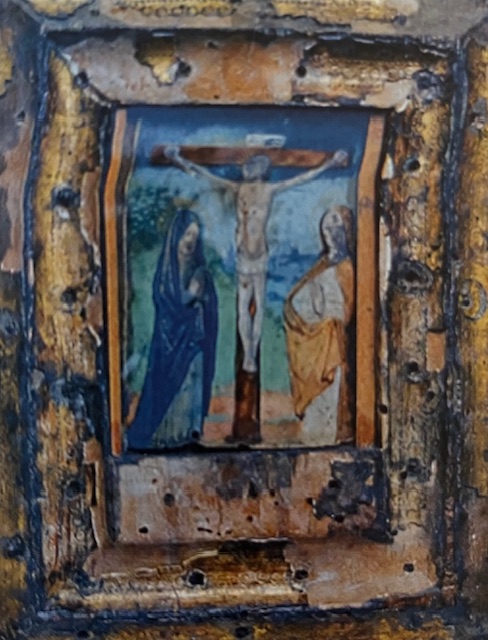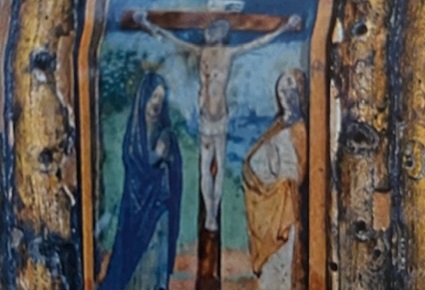In the Middle Ages, the passing of the peace was accomplished by the literal passing of a decoartive “pax tablet” amongst the parishioners, who would each kiss it in turn before it was presented to the next person. The pax tablets rose to prominence in the High Middle Ages, emerging out of the English church. They are first mentioned in the statutes of the Archbishop of York in 1248, though the context suggests it was already in common use by that time. The tablet’s exact origin is unclear; some scholars suggest it originated with the Franciscan Order. By the 1300s it had spread to other European countries and was standard in Latin Christendom by the Reformation. It went by various names: its Latin designation was instumentum pacis or pacificale, whilst in English it was known as the pax brede (“pax board”); in German it was called the Kusstafel (“kiss board”), and some Latin sources call it the Osculatorium (“osculatory,” from the Latin word os for mouth, meaning something that is touched by the mouth).
Material and Dimensions
The pax could be made of a variety of materials. Average parishes would have a tablet of painted wood or brass, but cathedral churches, eminent abbeys, and royal chapels used higher quality materials; paxes of ivory, gilded copper, silver, gold, or mother of pearl were used. They could be embellished with enamels, glass, or other ornamentation (some paxes doubled as reliquaries as well). Paxes might have a handle attached, or a slot or hoop for attaching a handle. The tablets were generally no larger than a foot in height, often smaller; the image on the pax usually was 4 to 6 inches high and situated within a frame of some sort. A survey of surviving paxes shows a great diversity of material and decoration; the only properties all paxes share in common seems to have been that it feature an illustration and that the surface be relatively flat for ease of kissing.
Decoration
The flat panel on the front of the pax was decorated with religious imagery, either in paint, relief, or engraving, according to the material the pax was constructed from. The most common images were of the Crucifixion or of the Madonna and child, but any pious image was suitable. Surviving paxes, for example, reveal a rich variety of illustrations: the Last Supper, Presentation, Annunication, Deposition from the Cross, and Coronation of Mary are all attested. Images of saints occasionally figure as well; the 1503 Eberbach Pax of the German Eberbach Abbey depicts St. Martin and St. Catherine (see below). Sometimes the illustration was allegorical, for example, an Agnus Dei image.


The image itself was often coated in a clear enamel, or else covered in glass or rock crystal so that it could be kissed repeatedly without degrading the image. Parishes sometimes possessed two paxes, one for common use and a more elaborate tablet for holy days. Some parishes had pairs of paxes, one for each side of the nave as divided by the central aisle.
Usage
It is generally agreed that the kissing of the pax tablet was introduced as a substitute for actual kissing, which was in practice throughout the first millennium. Liturgically, the pax tablet was passed during the Eucharistic liturgy, after the Agnus Dei. At the commingling—when the priest would place a particle of the consecrated host into the Precious Blood—the priest would kiss the chalice. Having kissed the chalice, he immediately took up the pax tablet and kissed it in turn, ceremonially transferring the kiss of the chalice to the tablet. He then passed it to the clerk, saying, “Pax tibi.” The clerk in turn kissed it and then passed it on to everyone else in the chancel (generally clergy, but persons of noble rank were sometimes allowed to sit in the chancel as well).
After all in the chancel had kissed the pax, one of the clerks or servers would present it to the laity. The 16th century Protestant author Thomas Becon recorded (with disapproval) that “the boye or parish clerk carrieth the Pax aboute.” (1) In smaller parishes this would have been done by means of extending the tablet on a handle, similar to today’s collection baskets on handles; in larger churches, the tablet was likely passed from person to person—although the server does not seem to have relinquished control of it, walking instead through the congregation and presenting it to each individual to kiss (some texts suggest the congregation stood for the pax). The pax was wiped with a cloth after each person’s kiss. The passing of the pax tablet seems to have happened simultaneously with the priest’s communion. (2)
An order of social precedence was observed in kissing the pax. We have noted it was kissed first by the priest, then members of the clergy and those in the chancel. When it went to the laity, it was taken to the most prominent members of the community first. Men took precedence over women, but not all men over all women; for example, women of higher status would kiss the tablet before men of lower status.
Not everyone was permitted to kiss the pax. It seems that women of public infamy were prohibited from touching it—for example, prostitutes. And a 13th century directive from the Archbishop pf Canterbury explicitly forbid priest’s concubines from touching or kissing the pax. (3)


Disputes
The passing of the pax tablet was the occasion of many disputes, generally relating to the order of precedence, which was deeply rooted in social status and could easily give offense. In The Canterbury Tales, Chaucer’s parson complains that people vyed with one another to kiss the pax first as a means of demonstrating their importance, which he regarded as the sin of pride:
And yet is there a private species of Pride that waits first to be greeted ere he will greet, although he is less worthy than that other is, indeed; and also he expects or desires to sit, or else to go before him in the way, or kiss the pax, or be incensed, or go to the offering before his neighbor, and such similar things, beyond what duty requires, indeed, but that he has his heart and his intent in such a proud desire to be made much of and honored before the people. (3)
This pride could and did result in angry outbursts. At the parish of All Saints Staining in London in 1496, a woman threw the pax to the ground and broke it when another kissed it first. (5) In 1518 in Huntingdonshire, a gentleman’s wife attempted to kiss the pax when it was not her turn, prompting an intervention by the chaplain and two assistants that caused a scene. (6) One particularly scandalous story comes from the Essex village of Theydon Garnon in 1522. English historian Nicholas Orme explains the incident:
On the Sunday before All Saints Day, John Browne, a gentleman in the parish but not the most important one, was alleged to have said to the parish clerk, “If thou hereafter givest not me the pax first, I shall break it on thy head.” When All Saints came, the clerk, Richard Pond, gave the pax first to Francis Hampden, the patron of the church, then to Margery his wife, and finally to Browne, who kissed it and allegedly then broke it into two pieces on the clerk’s head, causing streams of blood to run to the ground. (7)
Decline
Even during its heyday there were complaints about the disruptions caused by the pax tablet, with writers both lay and ecclesiastical, recommending alterations to the ritual, for example, affixing the pax to the wall where it could be kissed by whomever wished). Afte rthe Reformation Protestants abandoned the pax entirely, and in the spirit of renewed discipine that characterized the post-Tridentine era, the kissing of the pax went into decline, beginning to disappear around 1600. By this time, it had transformed from a symbol of Christian peace into a gesture of greeting to those deserving of honor, and as such was typically restricted to the clergy, nobility, and magistrates. (8) Today, the use of the pax tablet lives on primarily among the Dominicans, whose “Pax Instrument” is the modern descendant of the medieval pax tablets. (9)


(1) The Clerk’s Book of 1549, ed. J . Wickham Legg (London, 1903), XXXV
(2) Nicholas Orme, Going to Church in Medieval England (Yale University Press: New Haven, CT., 2022), 217
(3) Orme, 161
(4) Geoffrey Chaucer, The Canterbury Tales, “The Parson’s Tale,” Line 26.
(5) William H. Hale, A Series of Precedents and Proceedings in Criminal Causes 1475-1640. (London, 1847), 53-4. See also Eamon Duffy, Stripping of the Altars (Yale University Press: New Haven, 1996) 126-27
(6) Orme, 245
(7) Ibid.
(8) Frank C. Senn, The People’s Work: A Social History of the Liturgy (Fortress Press: Minneapolis, 2010) 188-189
(9) See Fr. Augustine Thompson, O.P., “The Pax Instrument,” New Liturgical Movement, July 28, 2008. Available online at https://www.newliturgicalmovement.org/2008/07/
fr.html#.VWt1VkaP9-w
Phillip Campbell, “The Pax Tablet,” Unam Sanctam Catholicam, Nov. 10, 2024. Available online at https://unamsanctamcatholicam.com/2024/11/10/the-pax-tablet

